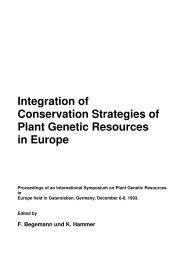Agrobiodiversität in Deutschland - Genres
Agrobiodiversität in Deutschland - Genres
Agrobiodiversität in Deutschland - Genres
Sie wollen auch ein ePaper? Erhöhen Sie die Reichweite Ihrer Titel.
YUMPU macht aus Druck-PDFs automatisch weboptimierte ePaper, die Google liebt.
20 | Johannes Engels<br />
From the earliest conservation and use activities<br />
of genetic resources until today<br />
activities of von Humboldt and Vavilov, will be explored. The importance of<br />
(plant) breed<strong>in</strong>g and genetic resources is another important dimension that<br />
needs to be dealt with as well, before mov<strong>in</strong>g to questions and issues related<br />
to access and benefit shar<strong>in</strong>g, genetic resources and politics. Some conclud<strong>in</strong>g<br />
remarks will be made at the end of the presentation.<br />
Farmers, domestication and agriculture<br />
The domestication of crops and animals is a key factor <strong>in</strong> the development<br />
of agriculture and an <strong>in</strong>tegral part of human evolution and civilization.<br />
Recent archaeological f<strong>in</strong>d<strong>in</strong>gs suggest that the process of domestication,<br />
and thus the orig<strong>in</strong> of agriculture, date back to approximately 11.000 years.<br />
The earliest well-documented domesticates occurred around that time <strong>in</strong><br />
the Near East (Iran/Iraq area, i.e. the Fertile Crescent) with wheat and barley<br />
along with goats and sheep as the ma<strong>in</strong> domesticates (http://courses.wash<strong>in</strong>gton.edu/anth457/agorig<strong>in</strong>.htm,<br />
consulted on 11.12.2011) and that there<br />
are a number of <strong>in</strong>dependent regions of the world where this has happened<br />
s<strong>in</strong>ce then. Farmers are key players <strong>in</strong> the domestication process, they select<br />
plant types of a given species consciously or sometimes just by chance<br />
that respond to their criteria and subsequently conserve those types from<br />
one season to another. Depend<strong>in</strong>g on the crop and the prevail<strong>in</strong>g genetic<br />
diversity this selection process can be more or less directional and the domestication<br />
process might take <strong>in</strong> some cases many years, sometimes many<br />
generations of farmers. The reproductive isolation of the material under<br />
domestication, i.e. non-domesticated population(s), is an important factor<br />
that <strong>in</strong>fluences the progress of the domestication <strong>in</strong> terms of changes and<br />
time. It can take millennia of years before a wild plant or population has<br />
been fully domesticated!<br />
Besides the aforementioned reproductive isolation also the ‘unrestricted’<br />
movement of the material with neighbours and other villages <strong>in</strong> a region is<br />
an important factor with a bear<strong>in</strong>g on the success of the domestication. It<br />
has been observed that traditionally farmers do care about their plant<strong>in</strong>g<br />
material and sometimes they even develop a sense of ‘ownership’ over the<br />
material that they cultivate/domesticate. However, with the spread of the<br />
human race around the world plant<strong>in</strong>g material has been carried along and/<br />
or the knowledge of domesticat<strong>in</strong>g wild plants was carried along and thus,<br />
the genetic resources and the related domestication knowledge have spread<br />
to other regions and cont<strong>in</strong>ents! It is the migration of people that made it<br />
possible to spread agriculture, the correspond<strong>in</strong>g crops and the cultivation/<br />
domestication knowledge from a few centres of orig<strong>in</strong> to the rest of the<br />
world. This movement of people and plants had a further and direct impact<br />
on agriculture as new crop <strong>in</strong>troductions usually do well <strong>in</strong> ‘new regions’,<br />
especially dur<strong>in</strong>g the <strong>in</strong>itial stages after <strong>in</strong>troduction as <strong>in</strong> general the traditional<br />
natural enemies of the crops <strong>in</strong> question do not migrate along with<br />
the plant<strong>in</strong>g material and thus, newly <strong>in</strong>troduced crops tended to be more<br />
productive <strong>in</strong> their new environment.<br />
Region of crop domestication and of diversity<br />
The orig<strong>in</strong> of crop plants is rather dispersed and somewhat erratic, although<br />
a clear concentration of domestication events <strong>in</strong> a limited number of regions<br />
or centres around the world have been observed and reported. Vavilov (1926)<br />
postulated eight centres of plant diversity and orig<strong>in</strong> of agriculture plus<br />
one smaller sub-centre <strong>in</strong> South America. It should be mentioned that these<br />
areas of crop domestication or orig<strong>in</strong> of agriculture are largely conf<strong>in</strong>ed to<br />
the tropical and sub-tropical belts of the world (see also Fig. 1) and generally<br />
located <strong>in</strong> mounta<strong>in</strong>ous areas. However, with <strong>in</strong>creas<strong>in</strong>g <strong>in</strong>formation on<br />
the orig<strong>in</strong> of crops and their respective centres of diversity it became clear<br />
that numerous crops had their orig<strong>in</strong> outside these centres of agriculture<br />
orig<strong>in</strong>. Scientists like Jack Harlan suggested that it would be more correct to<br />
speak of centres and non-centres of agricultural orig<strong>in</strong>s (Harlan 1975). Also<br />
Vavilov had realized that sometimes actually more genetic diversity for a<br />
given crop occurs <strong>in</strong> the so-called secondary centre of genetic diversity than<br />
<strong>in</strong> the actual centre of domestication. Even if centres of domestication and<br />
agriculture orig<strong>in</strong> do not have to co<strong>in</strong>cide with centres of diversity of our<br />
crop plants it can be stated that the mere concept that some regions <strong>in</strong> the<br />
world harbor more genetic diversity for crops than others this concept has<br />
been very important and useful <strong>in</strong> the conservation of PGRFA.<br />
Johannes Engels | 21










